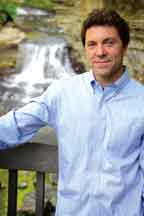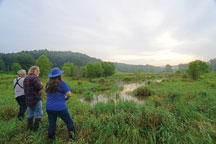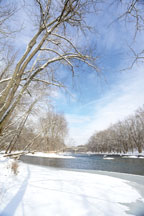Main Content
Article
Outdoor Indiana - November/December 2015 - Featured Stories
From the Director
Destinations
Trailing
More bears likely coming to Indiana, eventually
From the Director
HUNTING DRIVES CONSERVATION
Director Cameron F. Clark
 After an American hunter took down Cecil the lion in Africa earlier this year, much was said and written about hunting’s place in the modern world.
After an American hunter took down Cecil the lion in Africa earlier this year, much was said and written about hunting’s place in the modern world.
People lined up on either side of the issue, but few were more eloquent than Chris Madson, a gifted writer from Wyoming whose piece “Cecil’s death shouldn’t end hunting” on his website (thelandethic.com ) supports a broader view of hunting’s significant contributions to wildlife conservation:
“I recognize that many people with a genuine interest in conservation find hunting repugnant. I think that view fails to credit the seminal role hunting has played in the development of our species ... Ethical hunting has been an irreplaceable force for conservation over the last two centuries, and it continues to be critical to the success of wildlife conservation in North America.”
That role is present every day in Indiana, where hunters—and anglers—drive DNR’s conservation efforts. Their pursuits fund our Division of Fish & Wildlife and support economic development, which is one of the factors that affect a society’s view of resource protection.
Most of you are aware of the importance of the Pittman-Robertson Act of 1937. The federal Wildlife Restoration Fund created by Pittman-Robertson is funded by hunters. Without it, the landscape of wildlife in North America would be different today.
You can love wildlife and not be a hunter, but you best thank the hunter for the opportunity to see and appreciate wildlife in Indiana.
Destinations
STONE HEAD NATURE PRESERVE
A spiritual treat and retreat
Story & photos by John Maxwell, OI Staff
 Gazing down the road with unblinking eyes, the carved sandstone head marks the intersection of Bellsville Pike and State Road 135.
Gazing down the road with unblinking eyes, the carved sandstone head marks the intersection of Bellsville Pike and State Road 135.
It’s seen Brown County’s olden times, faithfully watching the seasons float through the forested rolling hills surrounding Salt Creek Valley since 1851. With a similar steadfast gaze, Stone Head Nature Preserve founder Mike Kelley sees a beautiful future for the valley.
Cutline: Stone Head Conservancy birders Jeff Riegel, Mike Kelley and Ann Maxwell count birds last July during a monthly survey in the preserve's Zimmerman Wetland.
To read the rest of this article subscribe to Outdoor Indiana or pick up a copy at most Barnes and Noble bookstores, and state park inns. To subscribe, click here or call (317) 233-3046.
Trailing
HOLLIDAY PARK
A slice of country in interior Indianapolis
By Nick Werner, OI staff
 Former Indianapolis businessman John Holliday made a fortune in the newspaper industry. In 1892, he built a 23-room home and estate. It served as a rural getaway from the family’s primary residence downtown.
Former Indianapolis businessman John Holliday made a fortune in the newspaper industry. In 1892, he built a 23-room home and estate. It served as a rural getaway from the family’s primary residence downtown.
“Back then this was a whole other world just driving 6 miles north,” Holliday Park property manager Adam Barnes said.
A lot has changed. The family donated the land to the city in 1916. Sixteen years later the city park opened. Now, the home is gone, and Indianapolis has expanded far beyond the old estate. The 94-acre park borders the White River near Meridian Street and Kessler Boulevard in what is now interior Indianapolis.
Cutline: The White River sweeps alongside Holliday Park in Indianapolis. The 94-acre city park features wooded trails, play areas, a nature center and "The Ruins"-an 1898 architectural facade.
To read the rest of this article subscribe to Outdoor Indiana or pick up a copy at most Barnes and Noble bookstores, and state park inns. To subscribe, click here or call (317) 233-3046.
More bears likely coming to Indiana, eventually
But when?
By Phil Bloom, OI staff
A lot happened between 1871, when a wild black bear wandered into northwest Indiana, and this past summer, when another showed up.
Cellphones, personal computers, and the automobile were invented. So were cornflakes, the modern zipper, microwave ovens, and pantyhose.
There were two World Wars, 27 men were elected President of the United States, and 12 U.S. astronauts walked on the moon. And even the Chicago Cubs won a World Series. In fact, they won two (1907 and 1908).
Accurately predicting baseball champions may not be the forte of wildlife biologists. But they think they have a handle on when the next bear—or bears—may arrive in the Hoosier state.
“My gut would say we could get resident females moving into southeastern Indiana within the next 10 to 15 years,” said Budd Veverka, research biologist with the Indiana DNR Division of Fish & Wildlife. “I suspect we will see continued reports come in from northern Indiana over the next few years, but the established population will likely be in southeast Indiana, along the Ohio River where most of the best habitat is.”
To read the rest of this article subscribe to Outdoor Indiana or pick up a copy at most Barnes and Noble bookstores, and state park inns. To subscribe, click here or call (317) 233-3046.
